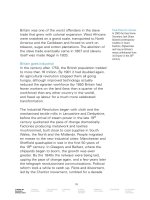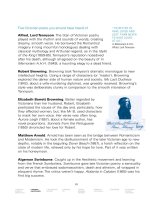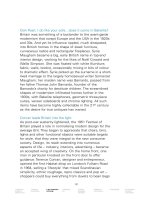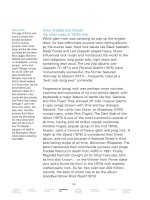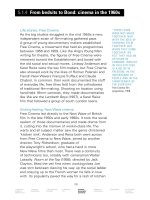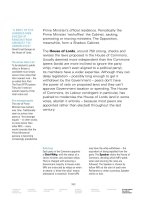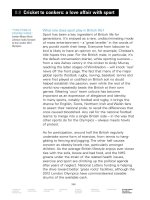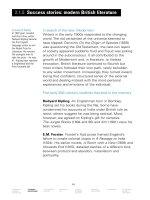Speak the culture britain be fluent in b 241
Bạn đang xem bản rút gọn của tài liệu. Xem và tải ngay bản đầy đủ của tài liệu tại đây (40.42 KB, 1 trang )
5.1.4 From bedsits to Bond: cinema in the 1960s
Life stories: Free Cinema
As the big studios struggled in the mid 1950s a new,
independent strain of film-making gathered pace.
A group of young documentary makers established
Free Cinema, a movement that held six programmes
between 1956 and 1959. Like the Angry Young Men
writing for theatre, the figures of Free Cinema were
irreverent toward the Establishment and bored with
the old social and sexual mores. Lindsay Anderson and
Karel Reisz were the key film-makers, but Free Cinema
also showed work by the likes of Roman Polanski and
French New Wavers Franỗois Truffaut and Claude
Chabrol. In common, their work documented the stuff
of everyday life, free (they felt) from the orthodoxies
of traditional film-making. Shooting on location using
hand-held 16mm cameras, they made documentaries
like We are the Lambeth Boys (1957), a Karel Reisz
film that followed a group of south London teens.
“TH ES E FI LM S
W ER E N O T M A D E
TO G ETH ER ; N O R
W I TH TH E I D EA O F
S H O W I N G TH EM
TO G ETH ER . B U T
W H EN TH EY C A M E
TO G ETH ER , W E
FELT TH EY H A D A N
ATTI TU D E I N
C O M M O N . I M PLI C I T
I N TH I S ATTI TU D E
I S A B ELI EF I N
FR EED O M , I N TH E
I M PO R TA N C E O F
PEO PLE A N D I N TH E
S I G N I FI C A N C E O F
TH E EV ER Y D AY.”
Free Cinema film
programme, 1956.
Sinking feeling: New Wave cinema
Free Cinema led directly to the New Wave of British
film in the late 1950s and early 1960s. It took the social
realism of those documentaries and made drama from
it, cutting into the marrow of workin-class life. The
warts and all subject matter saw the genre christened
‘kitchen sink’. Anderson and Reisz both went across
from Free Cinema to New Wave, joined by another
director, Tony Richardson, graduate of
the playwright’s school, who had a hand in more
New Wave films than most. There was a continuity
of technicians too, notably with cameraman Walter
Lassally. Room at the Top (1958), directed by Jack
Clayton, lifted the veil first when working-class Joe
was torn between clawing his way up the social ladder
and cosying up to the French woman he falls in love
with. Its popularity paved the way for a rash of kitchen
231
1. Identity: the
foundations
of British culture
2. Literature
and philosophy
3. Art, architecture
and design
4. Performing
arts
5. Cinema,
photography
and fashion
6. Media and
communications
7. Food and drink
8. Living culture:
the state of
modern Britain
